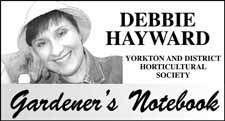Please circle Tuesday, August 12 on your calendars: that's the date of the Yorkton and District Horticultural Society "Fruit, Flower and Vegetable Show". The show is from 2 p.m. till 5 p.m. at St. Gerard's Parish Complex on Third Avenue. You'll see all types of beautiful and interesting displays and exhibits, and your admission includes coffee or tea and delicious dainties! Doesn't that sound like a nice way to spend the afternoon? Everyone is welcome, so please join us! That's Tuesday, August 12.
And for those of you who are interested in showing at or attending the Saskatchewan Horticultural Association Provincial Show, it is on Tuesday, August 19 in Windthorst. This is a judged show. For show books or more details please call Carol Miller at (306)224-4444.
"The Gardener For The Prairies" from Fall 1999 had a fascinating article by Betty Ternier Daniels about "Dryland Gardening in the 1920's". The article says that the idea was discussed in a 1926 bulletin entitled "The Prairie Farmer's Vegetable Garden" from the Canada Department of Agriculture, and promotes the idea that gardeners can grow a garden without watering, and that "cultural practises can compensate for low rainfall".
There were a few ideas listed to help make this happen. The first was that the garden should be sheltered from the wind, which quickly takes away any moisture in the soil. The garden should be planted as early as possible to take advantage of the spring moisture. All plants should be planted at "ground level", no raised beds. Weeds should be kept under control, so that they would not be sapping any moisture away from the other plants. It was suggested that a layer of well-rotted manure be spread around the garden to enrich the soil and also to help hold in moisture. For potatoes, the rule was no hilling. Cucumbers should be planted in a "saucer-shaped depression" to help collect and conserve any rainfall.
It is an intriguing idea, so I did a little more research and read about two neat things I wanted to share with you. I went on a site called growveg.com, and read an interesting article by Barbara Pleasant called "Dryland Gardening: A Worldwide Report".
One technique Ms. Pleasant mentions in saving moisture are "waffle gardens": these have been used by the South-West Zuni Indians, and uses the technique of planting seeds in a cluster rather than a row. Then, soil is built up in a square around the seeds, to make a "frame" about 12 to 18 inches square. This will collect and save rainfall. The resulting effect across the garden looks like a waffle.
The second cool thing she mentions are "ollas", which are clay jugs that are sunk into the soil at planting time, with only their flared necks exposed. The ollas are filled with water or collect rainwater; they have small holes which then slowly and gently leak water back into the surrounding soil, providing moisture to the plants. She says: "Personally, I have no ollas, but an unlimited supply of plastic drink bottles I use a sharp knife to jab 5 or 6 small holes in the bottom half of a bottle, and then "plant" it between tomatoes. After filling the buried bottles with water, I screw on the caps, which slows the percolation of water into nearby soil. Because all of the water in buried bottles is released several inches below the surface, not a drop is wasted. This is dryland gardening at its best."
We should file these ideas away for next year! So much to learn, gardeners! Have a great week, and if you're working outside, be sure to wear a hat!




